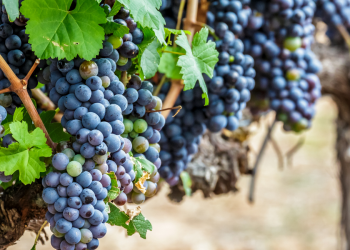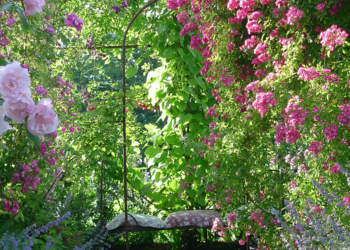Pinot Noir was never my favorite wine varietal — and Oregon wasn’t on my destination radar. I (used to) prefer heavier, darker, fuller wines than the Burgundian style of Pinot Noir, which tends to have notes of juicy red fruit, like strawberry, pomegranate, and cherry. But when I discovered I could blend my own Pinot Noir with the talented Bryan Weil of Alexana Vineyards through an experience company called The Vines, I jumped, or rather flew to Portland, as the case may be. I like having my mind changed by wine. (The Vines also lets its members make their own Champagne with Champagne Drappier in France, Brunello in Montalcino, and Grenache- and Carignan-based wine with Dominik Huber in Priorat, Catalonia, among other “blending escapes.”)
It’s crazy to think how young the whole concept of Oregon Pinot Noir is. Last century, Pinot lovers decided California was basically too hot and sunny for their sensitive, thin-skinned grapes. Two pioneers, David Lett and Charles Coury, packed up their Pinot dreams in the mid-1960s and moved to the valley — Willamette Valley that is. The AVA was created in 1983 and when people say they love Oregon Pinot Noir, it comes from here. Willamette (pronounced Will-amnit, damnit!) Valley has some of the richest soil in the country, with marine sediment from crashing tectonic plates (for darker, drier fruit), volcanic basalt from lava (for lighter, red fruit flavor), and now 600 wineries producing Pinot Noir. It’s a corridor of cool air and emerald hills, a direct shot 40 miles in from the Pacific.
All the talk about smuggled vine clippings and Burgundian clones can make your head spin, and so can blending wine for hours and hours — in a good way. But even if you are not a Pinot lover, you can still enjoy the supernatural feeling of chilled Pacific air flowing into this valley against a backdrop of prehistoric volcanoes Mt. St. Helen’s, Mt. Rainier, and Mt. Hood, and the velvety, rolling hills that grow all the hazelnuts in the U.S. (second producer in the world only to Turkey). The way it all comes together — I promise I won’t use the word terroir — is bewitching. And just maybe you will fall under the spell of Pinot Noir (and Chardonnay, Pinot Gris, and Rosé) as I have.
WINERIES TO VISIT

Alexana Vineyards
Bryan Weil is a lot of fun to blend wine with. With vials and beakers and bottles, our task was to mix the juices from various areas in Alexana Vineyards till we liked it. After a few hours of beaker-ing, my concoction was declared by Bryan to be “a non-Pinot Pinot”. The Willamette blending escapes is an annual occurrence with The Vines, but if you are touring, Alexana also offers a variety of in-person and virtual tasting experiences, private dinners and events.
Chehalem Tasting Room and Wine Bar
The Chehalem Mountains are at one end of the valley and contain both the old marine sedimentary soil and the younger volcanic soil. Chehalem vineyard, planted in 1983, is now an all-women-run winery owned by Bill Stoller that produces excellent Chardonnay and Pinot Noir, especially from 2018 which they call a “Cinderella year.” Chehalem cares a lot about sustainability; skipping herbicides and implementing dry farming whenever possible; they have an eco-zone on their vineyard for native plants and animals. Visit the tasting room in downtown Newberg, open daily. I loved the 2019 Chardonnay Reserve which tastes more like a white Burgundy than a Napa Chardonnay, because it is.
Bethel Heights
A little farther out in the valley is the Eola-Amity Hills AVA. Even though they have lots of volcanic basalt soil, Bethel Heights Pinots are a little darker and spicier. I heard familiar descriptors like “rustic, coffee, and chocolate,” — more of what I’m used to! Family-owned and run, Bethel Heights Vineyard has an incredible view of the valley, organic certification, 85 acres of Pinot Noir vines, and a beautiful Rosé of Pinot Noir. The mineral-style, barrel-fermented High Wire Chardonnay was worth the trip. Book a wine tutorial with the winemaker Ben Casteel, or a tasting, I promise you won’t leave without a case of something.
WHERE TO STAY
The Allison Inn & Spa
The Allison Inn & Spa is a resort in Willamette Valley where you stay to recoup from all the wine tasting. Spacious with steel and glass framed seating areas, everywhere you look is a comfortable spot to look out over the valley, order a refreshing green salad (with hazelnuts of course), or have another glass of wine from their restaurant Jory. Allison Spa services are still a bit limited due to the pandemic, so book your detox massage in advance.
Atticus Hotel, McMinnville
The boutique Atticus Hotel has 36 rooms in the historic downtown of McMinnville, the quaint, restored, ye olde town where you will find lively restaurants, tasting rooms, art galleries and lots of knick knacks. With its chic gray façade and black awnings, this sophisticated gem of a hotel is not part of any chain, so it has a kind of indie luxury vibe. Owned and run by a non-profit executive, graphic designer, and avid gardener, they are locals who love Oregon wine and will help you plan your visit.
WHERE TO EAT
Pura Vida Cocina, McMinnville
A fantastic Latin American restaurant in the historic town of McMinnville is Pura Vida Cocina, family-owned and operated by Ricardo Antúnez; he is also the chef. Local, healthy ingredients go into creative meals that combine dishes from Costa Rica, Cuba, El Salvador, Perú, Argentina and Ecuador. Try ceviche of shrimp and Pacific salmon, fried avocado (OK, maybe not the healthiest), duck confit tostadas with super-hot habanero sauce, swordfish tacos with pickled cabbage in hand-pressed red tortillas, and a blood orange margarita. Follow the meal with an after-dinner Fireball across the street at the Blue Moon Lounge — cash only, that says it all!
Red Hills Market, Dundee
This freestanding building that Red Hills Market calls home in Dundee is a food lover’s paradise, serving lunch, dinner, grab-n-go and carry-out meals with seasonal ingredients, including wood-fired garlic cheesy bread, smoked trout salad, and fall fungi wood-fired pizza. (They also offer accommodations called The Market Lofts.) Truth is, the two amazing meals we enjoyed from Chef Jody of RHM were out of the back of his truck, literally. It’s a full-fledged wood-burning oven truck that first produced a lunch of lamb merguez and pepperoni pizza followed by their “monster cookies”. The second experience was a live-fire salmon bake in the Alexana vineyards, a traditional Native American method with wild salmon seasoned like lox, slow-smoked over Alder firewood for four hours, served with roasted artichokes and smashed potatoes. Hazelnuts roasted with rosemary were the perfect tasty wine snack. Check out their foodie cocktail events including Sunday Brunch (every Sunday) and Locals Night (every Monday).
WHAT ELSE TO SEE
Frank Lloyd Wright “The Gordon House”
One of Frank Lloyd Wright’s philosophies, paraphrased, is that when you’re living in a place, you’re also living outside the place. The environment is integral to the interior. A Usonian House such as his Gordon House, also connects with nature. Lloyd Wright’s only house in Oregon was smartly moved to the Oregon Garden, its current location, in 2001. The interior also reflects typical Lloyd Wright design philosophy, with all angles including the banquette in the kitchen at a strategic 15-degrees to reproduce the comfort of the original owner’s bench seat in his pick-up truck. Worth a visit.
OTHER ICONIC WINES OF WILLAMETTE VALLEY
In case you have more time, here are wines I tasted that would be worth a vineyard visit.
2017 Hyland Estates Coury Clone Pinot Noir (McMinnville AVA) — The Coury clone (vine cutting) was supposedly smuggled in a suitcase from Alsace, France and planted in Oregon. This wine is from the second oldest vineyard in the valley planted in 1971-72. “Things are more enjoyable the more you know about them,” said our guide to these wines, Jeff Lewis of Alexana Vineyard.
2018 Elk Cove Mount Richmond Pinot Noir (Yamhill-Carlton AVA) — Willamette Valley pioneers, the Campbells planted Mt. Richmond in 1996. This family-owned vineyard is 400 acres. Grapes are hand-harvested and wine is made from the estate only. My favorite of the tasting.
2018 Rex Hill Jacob Hart Vineyard Pinot Noir (Chehalem Mountains AVA) — This is the “crown jewel” of the Chehalem Mountains, these vines were originally planted in 1987 on a rare hillside of both volcanic and marine sedimentary soils. 36 acres are biodynamically farmed and only 400 cases of this are produced.
2019 Patricia Green Estate Pinot Noir (Ribbon Ridge AVA) — Tastes fresh, floral, with bright red fruit , this Pinot is from 100% Pommard clone vines, planted in 1998-2000.







